A Matrix Method for Determining Eigenvalues and Stability of Singular Neutral Delay-Differential Systems
Abstract
The eigenvalues and the stability of a singular neutral differential system with single delay are considered. Firstly, by applying the matrix pencil and the linear operator methods, new algebraic criteria for the imaginary axis eigenvalue are derived. Second, practical checkable criteria for the asymptotic stability are introduced.
1. Introduction
Nowadays, the time-delay systems have became an important natural models in physics, engineering, multibody mechanics, computer-aided design, and economic systems. The theory on ordinary differential equations with delays have been discussed for decades in a wide range, so there are very many results for them. Especially, the eigenvalues and the stability analysis of time-delay systems have received much attention of researchers and many excellent results have been obtained, see [1–6]. Certainly most of them had been focused on the analytical methods or numerical methods, such as V-functional methods, Laplace transformation, Runge-Kutta methods, and linear multistep methods. In [7–9], the numerical techniques for the computation of the eigenvalues were discussed. In [10], Zhu and Petzold researched the asymptotic stability of delay-differential-algebraic equations by applying the θ-methods, Runge-Kutta methods, and linear multistep methods. These methods play the key roles at last. But in recent years, algebraic methods are developing fast, especially for the research on the more complex systems, such as the n-dimensional systems. Though the algebraic methods as a new and effective tool is also applied to analyze the time-delay systems [2, 3], the results are very few.
In this paper, we will discuss the differential-algebraic equations by the algebraic methods. Their dynamics have not been well understood yet.
Example 1.1. Consider the simple differential-algebraic system:
In this paper, we will apply the algebraic methods to discuss the stability of a singular neutral differential system with a single delay, as follows:
2. The Algebraic Criteria for Determining Imaginary Axis Eigenvalues
Lemma 2.1. For all complex s, , and so det T0(s) = ±det Λ0(s).
Proof. Let , where a = (sB0 − A0) ⊗ I, b = (sB1 − A1) ⊗ I, c = I ⊗ (sB1 + A1), and d = I ⊗ (sB0 + A0). Noting the Kronecker product identities (I ⊗ M)(N ⊗ I) = (N ⊗ I)(I ⊗ M) = N ⊗ M, we have db = bd, bc = cb. By regularity of (B0, A0), we know sB0 + A0 is nonsingular for enough complex s. So by the property of the polynomial and easy computations, we can get that for any complex s. Elsewhere,
Theorem 2.2. Any imaginary axis eigenvalue of the systems (1.5) is a zero point of det Λ0(s) and thus also one of the eigenvalues of the matrix pencil (E0, F0).
Proof. The matrix polynomial for the system (1.5) is
From Theorem 2.2, we know that all of the imaginary axis eigenvalues of the system (1.5) are zero points of the algebraic equation
Corollary 2.3. If det (B0 ⊗ B0 − B1 ⊗ B1) ≠ 0, then E0 is invertible, and any imaginary axis eigenvalue of the systems (1.5) is the eigenvalue of .
Corollary 2.4. Any imaginary axis eigenvalue of the system with single delay
Proof. It follows immediately from Theorem 2.2.
In fact, the above result contains the system (1.6). For the system (1.6), we also have the following corollary.
Corollary 2.5 (see Jarlebring and Hochstenbach [2], Theorem 1.)For the system (1.6), the imaginary axis eigenvalues are the roots of the equation
Remark 2.6. In fact, (2.23) or (2.26) is usually called a polynomial eigenvalue problem. The classical and most widely used approach to research the polynomial eigenvalue problems is linearization, where the polynomial is converted into a larger matrix pencil with the same eigenvalues. There are many forms for the linearization: the companion form is most typically commission. The linearization method is also an important tool to research the characteristic equations in algebraic methods, see [2, 13].
From the above results, we find that the imaginary axis eigenvalues of the system (1.5) or (1.6) can be computed via the algebraic equation (2.23) and (2.26). The imaginary eigenvalues play an important role in the stability. Next, we will use the results to discuss the stability of the systems. At first, we will give the condition of the delay-independent stability on the system (1.5). Secondly, we will address the problem of finding the critical delays of the system (1.6), that is, the delay such that the system (1.6) has purely imaginary eigenvalues.
3. The Algebraic Criteria of the Asymptotic Stability
The stability of the delay ordinary differential equations has been widely discussed [14, 15]. It is well known that the Lyapunov-Krasovskii functional approach is the important analytic method to find the delay-independent stability criteria, which do not include any information on the size of delay. The main ideas for developing algebraic criteria of the stability analysis on the systems can be found in many works, such as “The Degenerate Differential Systems with Delay” (W. Jiang, 1998, [12]). The results for singular neutral differential equations are still very few, especially by algebraic methods.
From [12], we known that the solution of the neutral time-delay systems is asymptotically stable if all roots of (3.1) have negative real part bounded away from 0, that is, there exists a number δ > 0, such that Re(s) ≤ −δ < 0 for any root s of (3.1). Especially for the system (1.5), Zhu and Petzold had found that there must exist the δ, if the condition |uTB0u| ≥ |uTB1u| for all u ∈ ℝn holds, see [10]. So from [3, 10], we can get the following theorem.
Theorem 3.1. Let s be the zeros of (2.23). If the coefficient matrices of the system (1.5) satisfies the following conditions:
- (i)
Reλ < 0, λ ∈ σ(B0, −A0),
- (ii)
max Res=0ρ((sB0 − A0) −1(sB1 − A1)) < 1,
Proof. It follows immediately from [10].
In the following, we consider the neutral system (1.6), whose characteristic equation is denoted by
Theorem 3.2. Supposing all of the eigenvalues of matrix A0 have negative real part and ρ(B1) < 1, one has the following.
- (i)
If for any root s of (3.2), Re(s) < 0, else if for any root s = iw, w > 0, z = e−sτ, |z| < 1, then system (1.6) is asymptotic stability for any τ ≥ 0, that is, stability is delay independent.
- (ii)
Otherwise, for each root s = iw, w > 0, |z| = 1, one can get the minimal critical value of delay parameter τ*, such that if τ ∈ [0, τ*), then system (1.6) is asymptotic stability, and when τ ≥ τ*, the stability of system (1.6) changes, that is, the system (1.6) is delay-dependent stable and generates bifurcation in τ = τ*.
Example 3.3. Consider a neutral neural networks with a single delay, see [16]:
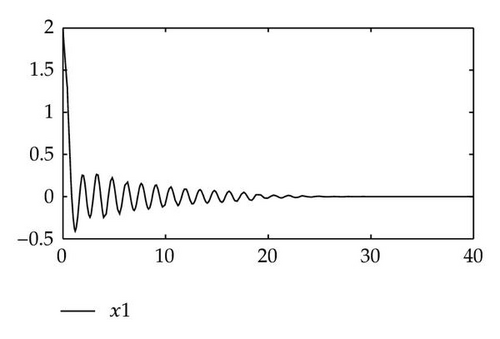

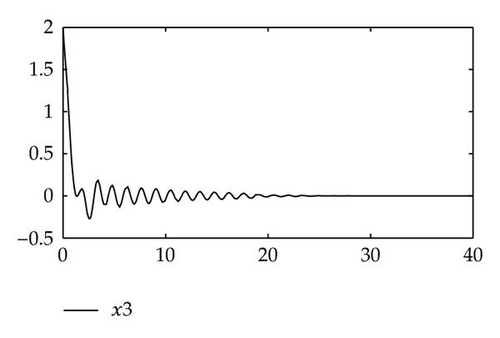
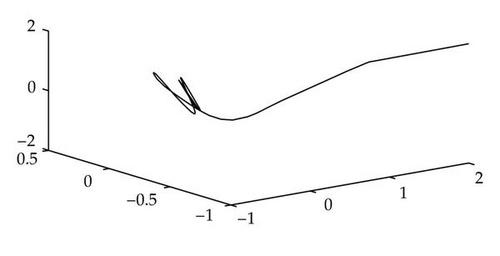
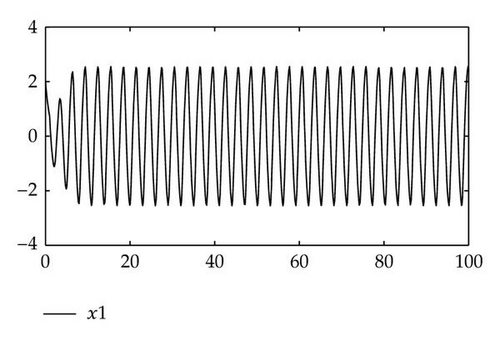
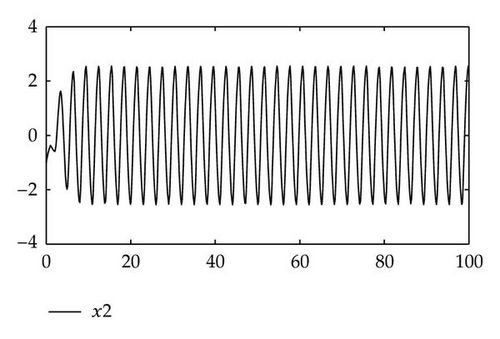
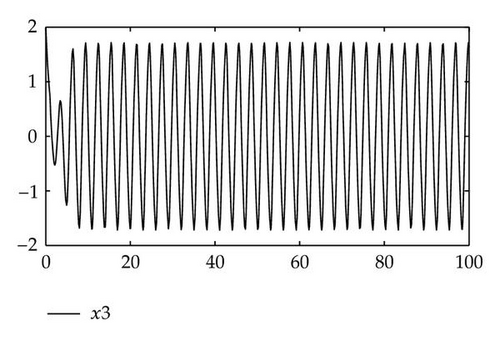
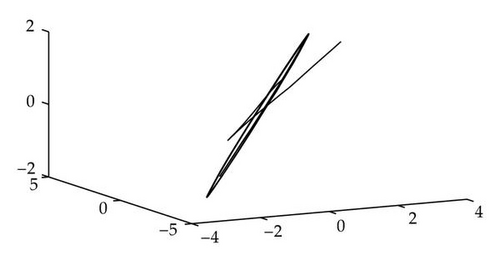
4. Conclusion
In this paper, we consider a singular neutral differential system with a single delay. Via applying the algebraic method, that is, the matrix pencil and the linear operators, we discussed the eigenvalues and the stability of the time-delay systems (1.5) and (1.6). By using MATLAB, we could easily compute imaginary eigenvalues from the algebraic equation (2.23) or (2.26). In fact, we only find the imaginary axis eigenvalues, which are the small part of the infinite eigenvalues. So compared with the analytic methods and the numerical methods, the algebraic methods are more simple and more explicit for some time-delay system. Certainly, applying the algebraic methods to analyze the dynamical properties of the singular neutral differential systems with delays is a new and immature field. So we believe that the algebraic methods used to research the stability of the dynamical systems would be more interesting in the future.
Acknowledgments
The National Natural Science Foundation of China (10871056) and the Fundamental Research Funds for the Central Universities (DL12BB24) are greatly acknowledged.




